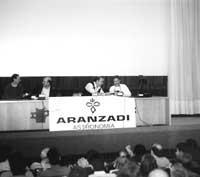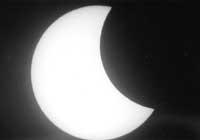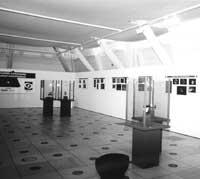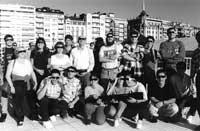Department of Astronomy of Aranzadi

Who are we?, What are we?
The Astronomy Section of the Aranzadi Science Society has been organizing a series of lectures on astronomy for six years. We have six years of experience and, first of all, we must emphasize that year after year the level of speakers has improved. The first year the talks were given by the members of our department, but since then, and the clearest example of this is the edition of this year, in which professionals with a high astronomy index have attended. In addition, every year the answer has been excellent. In many talks the room has been filled with people and that is precisely what encourages us to move forward.

After six years, the series of lectures on astronomy is becoming famous and known in our environment; more and more people are interested in astronomy, and as a sign of it is the crowd that attends the events organized by the Department of Astronomy.
The aim of the talks is to bring astronomy, and more broadly science, to all those interested in a comprehensible and technical way. Research by astronomers or scientists often extends in a very small field. The data obtained from a certain research or project rarely reach us if it is not very technical.
Even when you realize all this in the media, they do not give the necessary precision and often come out with huge or limited errors to the sensationalist title. In these talks we try to make these investigations known in an interesting way for everyone; we believe that the best way to do so is to go to the scientist who has done the same research. In short, this is the essence of the activities organized by the Department of Astronomy of Aranzadi: direct transmission of dissemination, approach between transmitter and receiver.
In recent years we have heard news about astronomy at any time. The probes sent to another planet, such as Galileo; those that have been created to study the Sun as Ulisses or Soho; the last giant telescopes that have been placed on Earth or the first optical telescope placed in space, the Hubble Space Telescope, along with others, are the culprits of relatively frequent news.

For this reason, we found it interesting to make known the lecture series of this year on the tools that man has created and which he has designed for the next century. And so we ask the guests.
Riccardo Giacconi told us the largest optical telescope in the world under construction, the Very Large Teleskope. The head of this telescope is ESO (European Southern Observatory) and Riccardo is the director of this organization.
In the second talk we learned about the discoveries of the Hubble Space Telescope. Luciana Bianchi informed us directly about these topics, which in his day to day uses the telescope frequently.
Alvaro Giménez told us why the probes sent to space and the spatial tools of observation that are still in progress and that will be launched soon. Finally, Ricardo Amils and Carlo Eiro informed us of the planets that have recently been found from the Solar System around other capo stars, and we asked them if, as is normal, there is life on those planets, or there may be.
This year the cycle of conferences II of the Spanish Society of Astronomy was developing. The Scientific Meeting was held. The SEA needed space for this meeting and we speakers for our talks, so in collaboration with both associations, we elaborated this year's program: Conferences of Aranzadi and meeting of the SE. The SEA organization was founded in 1991 and consists mainly of astronomers and astrophysicists from the Spanish state. The aim of the association is to define the way forward for astronomy in the State.

II. In the Scientific Session, astronomers from all over the State met and two main areas were discussed: on the one hand, newly doctoral students presented their theses so that community members could know in more detail what work or research they are doing at this time, and on the other hand, they debated on which European projects or the US should participate in the Spanish State. In this way it is discussed whether or not to enter the ESO projects in the southern hemisphere. In addition, at the meeting in Donostia the first steps were taken to implement the 10 meter telescope that ESO will build in the Canary Islands.
Fortunately, collaboration between the two associations was not limited to talks. With the aim of bringing everyone who is interested in astronomy closer, this year we have worked a third way: an exhibition. As mentioned, the optical telescope installed on Earth, the probes we have on the lip, and especially the Hubble Space Telescope, have given much to say in the last two years. So we decided to gather in an exhibition the most interesting and spectacular photographs we have obtained through these tools.
The exhibition took place in the Ganbara room of the Koldo Mitxelena Cultural Centre. At first we did a 4-day schedule, but seeing the success obtained among people, the offer was extended to another 4 days. During these eight days more than 2,000 people approached. Undoubtedly, the fact of having achieved a wide echo will lead us to continue making use of this path and it is possible that a traveling exhibition can be organized that can be visited by more people moving to other rooms.

In addition to the photo, we put a collection of stamps and meteorites, and at the last minute we managed to bring six models of the association that manages NASA satellites. Among them, the Hubble Space Telescope and the IUE (International Ultravioler Explorer). The U.S. was predicted to have a life of four or five years, but it has been eighteen years since it began to work and was able to continue collecting data; due to economic problems, on September 30 it was decided to turn them off.
Before we finish, we must show our support to sponsors who have made it possible for all these activities to come true: FotoKai, Druck, Central Galleries, Riu Tours, Hotel Londres, Kutxa, Diputación de Gipuzkoa, Departamento de Cultura del Ayuntamiento de San Sebastián, Koldo Mitxelena Kulturunea, Escuela Superior de Ingenieros y Diario Vasco.

Partial eclipse of the Sun
Last October 12 we had the opportunity to see a partial eclipse of the Sun from Euskal Herria. As is known, in the observation of the Eclipse of the Sun we must be very careful, never to look directly at the sun, not at first sight, much less through any apparatus, because in a few seconds the sun will burn our retina. The safest way to observe is to project the Sun on a screen, as you can see in the image below.

As with other astronomical phenomena, the Department of Astronomy of Aranzadi took to the street its telescopes to show the people who approached the place the fonomene. Thus, we placed two telescopes at Alderdi Eder in Donostia. As has already been indicated, the telescopes have a projection screen that we can see in the photo to be able to see them in a simple and safe way.
In addition to carrying telescopes, this year for the first time we offered special glasses to see eclipses coming from the United States. These glasses allow us to observe the solar eclipse without any danger, since it does not let pass the brightness of the sun or its ultraviolet rays. These glasses are really recommended for their low cost and safety.
The eclipse began at 3 and 12 minutes and ended at 5 and 40 hours, covering 50% of its face. Fortunately, as in many other occasions, the day appeared very clear to us. During the eclipse no cloud was seen and this gave us the opportunity to see the phonomen that does not occur often.

Until the end of the century we will see another partial eclipse of the Sun in Euskal Herria: August 1999. In addition, there will be a total eclipse from the north of France, so anyone who does not want to wait until 2026 to see the total eclipse of the Sun from the Basque Country can do so within three years.
Buletina
Bidali zure helbide elektronikoa eta jaso asteroko buletina zure sarrera-ontzian










